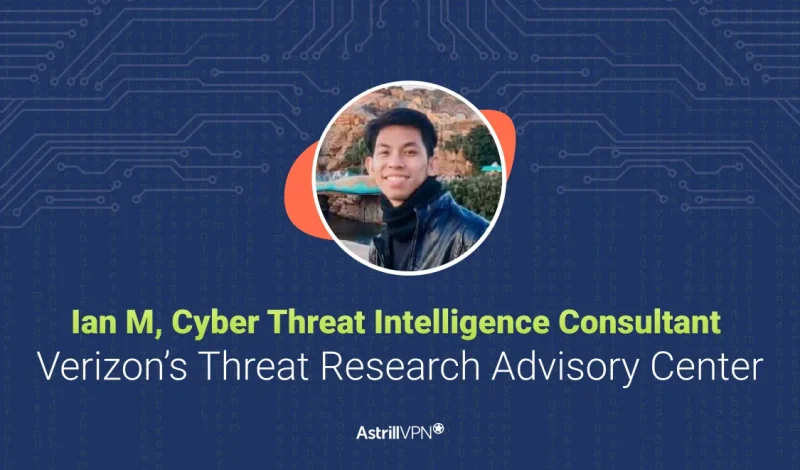Rise of AI-Driven Cyber Attacks: Expert Interview with Verizon Analyst

Arsalan Rathore

The cybersecurity landscape is undergoing a fundamental transformation as artificial intelligence becomes both a powerful defensive tool and a sophisticated weapon in the hands of cybercriminals.
To understand this evolving threat landscape, AstrillVPN spoke with Ian M, a Cyber Threat Intelligence Consultant at Verizon’s Threat Research Advisory Center (VTRAC). With extensive experience in dark web threat hunting, malware analysis, and incident response, Ian provides unique insights into how threat actors are weaponizing AI technologies and what organizations must do to defend themselves.
In this exclusive interview, Ian shares his expert analysis on the most concerning AI-driven threats of 2025, the increasing sophistication of attacks, and practical strategies for building robust defenses against this new generation of cyber threats.
AstrillVPN: To begin, could you please share a brief overview of your professional background as Cyber Threat Intel Consultant at Verizon, and how your work in recent years has shaped your expertise in addressing cybersecurity threats?
Ian M: As part of the Verizon Threat Research Advisory Center (VTRAC), our team focuses on Cyber Threat Intel specializing in Dark Web Threat Hunting. This role led us to be knowledgeable on how extensive and dangerous today’s threat landscape and threat actors are, may it be through the surface web or dark web, and addressing these cyber threats doesn’t only end in blocking IOCs.
From phishing pages down to the stolen credentials being sold on the dark web, it is our role to pro-actively act upon the intel for our customers’ brand protection.
AstrillVPN: From your experience, what are the most concerning AI-driven cyber threats you’ve observed in 2025? Which specific attack vectors are evolving fastest?
Ian M: As Artificial Intelligence becomes more and more advanced these days, threat actors also abuse such technology.
In 2025, Phishing attacks with the help of AI, or AI Phishing and Impersonation attacks, are the ones observed to be quickly evolving, and the most used in today’s attack vectors.
These AI driven Phishing attacks create more convincing impersonations and could lead to information stealing, such as credential stealing through phishing forms, or through downloads of information stealing malwares.
AstrillVPN: How has AI changed the sophistication and personalization of attacks compared to traditional methods? What makes AI-powered attacks particularly dangerous?
Ian M: Traditional methods are still present, but what makes AI more dangerous is the fact that it can impersonate even small details of a brand or a website, and more so, could even produce output in a faster manner, and could even do automation, much more reliable and easy to operate for threat actors.
AstrillVPN: What are the most effective strategies organizations should implement to defend against AI-driven attacks? How should security teams adapt their approach?
Ian M: Traditional or AI driven, outputs are still the same, especially in the hands of a skilled threat actor. However, the most effective way in battling these new techniques is through user education and training. Employee’s constant knowledge of today’s cyber threat landscape is one’s weapon for cyber security.
Pro-active approaches besides blocking of IOCs, such as immediate actions for credential resets from dark web exposures and patching of vulnerabilities, and monitoring cyber footprints, help in strengthening organizations’ cyber security.
AstrillVPN: Based on your observations, how prepared is the cybersecurity industry to handle the scale and sophistication of AI-powered threats? What are the biggest gaps?
Ian M: The cybersecurity industry is closing the gap in terms of handling scale and sophistication of these AI-powered threats. Cyber threat defenses today incorporate AI driven methods to pro-actively detect and alert the organization and automatically respond to scenarios, with less user interaction.
Key Takeaways
- Artificial intelligence is proving to be both a critical tool for cybersecurity defense and a powerful weapon for cybercriminals.
- AI-powered phishing and impersonation attacks are the fastest-evolving vectors, enabling more convincing scams and credential theft at scale.
- Unlike traditional methods, AI allows threat actors to rapidly replicate brand and website details, automate campaigns, and operate more efficiently.
- User education and continuous awareness remain essential. Proactive measures such as rapid credential resets from dark web exposures, timely vulnerability patching, and cyber footprint monitoring significantly strengthen resilience.
- While the cybersecurity industry is advancing by integrating AI-driven defenses for detection, alerting, and automated responses, the pace of adversarial innovation continues to present challenges.
- Combating AI-driven cyber threats requires a balance between advanced technological defenses and informed, vigilant users.
Conclusion
Ian M.’s insights from Verizon’s Threat Research Advisory Center paint a clear picture of the cybersecurity challenges facing organizations in 2025. While AI has undeniably empowered threat actors with more sophisticated tools for impersonation and automation, the cybersecurity industry is actively adapting to meet these evolving threats.
_______________________________________________________________________________________________________________
This interview was conducted as part of AstrillVPN’s ongoing commitment to cybersecurity education and awareness. For more expert insights and security resources, visit our blog and security center.


No comments were posted yet